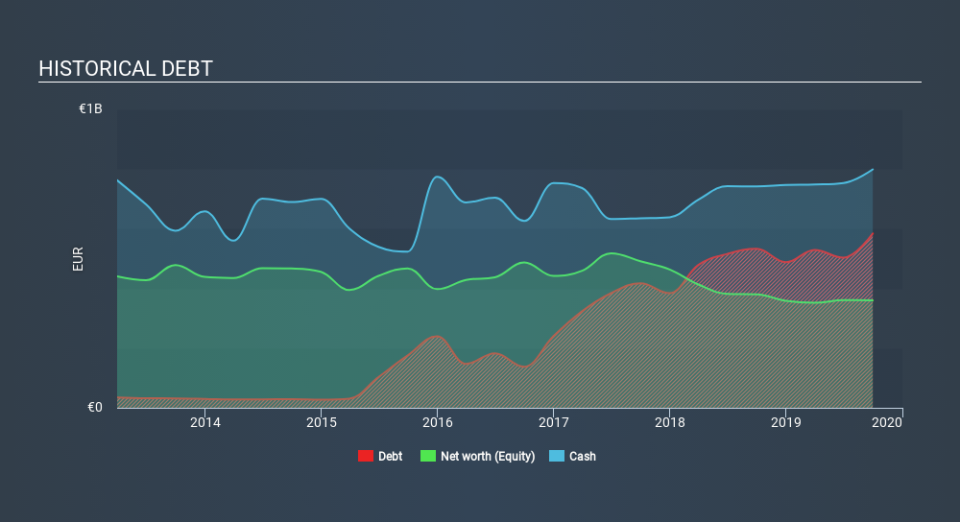Técnicas Reunidas (BME:TRE) Seems To Use Debt Quite Sensibly

Warren Buffett famously said, 'Volatility is far from synonymous with risk.' When we think about how risky a company is, we always like to look at its use of debt, since debt overload can lead to ruin. Importantly, Técnicas Reunidas, S.A. (BME:TRE) does carry debt. But the more important question is: how much risk is that debt creating?
When Is Debt A Problem?
Debt assists a business until the business has trouble paying it off, either with new capital or with free cash flow. If things get really bad, the lenders can take control of the business. However, a more usual (but still expensive) situation is where a company must dilute shareholders at a cheap share price simply to get debt under control. Of course, debt can be an important tool in businesses, particularly capital heavy businesses. The first thing to do when considering how much debt a business uses is to look at its cash and debt together.
View our latest analysis for Técnicas Reunidas
How Much Debt Does Técnicas Reunidas Carry?
As you can see below, at the end of September 2019, Técnicas Reunidas had €534.8m of debt, up from €533 a year ago. Click the image for more detail. However, it does have €799.2m in cash offsetting this, leading to net cash of €264.4m.
A Look At Técnicas Reunidas's Liabilities
According to the last reported balance sheet, Técnicas Reunidas had liabilities of €3.66b due within 12 months, and liabilities of €342.2m due beyond 12 months. Offsetting this, it had €799.2m in cash and €2.96b in receivables that were due within 12 months. So its liabilities outweigh the sum of its cash and (near-term) receivables by €245.4m.
Since publicly traded Técnicas Reunidas shares are worth a total of €1.26b, it seems unlikely that this level of liabilities would be a major threat. Having said that, it's clear that we should continue to monitor its balance sheet, lest it change for the worse. Despite its noteworthy liabilities, Técnicas Reunidas boasts net cash, so it's fair to say it does not have a heavy debt load!
And we also note warmly that Técnicas Reunidas grew its EBIT by 18% last year, making its debt load easier to handle. When analysing debt levels, the balance sheet is the obvious place to start. But it is future earnings, more than anything, that will determine Técnicas Reunidas's ability to maintain a healthy balance sheet going forward. So if you want to see what the professionals think, you might find this free report on analyst profit forecasts to be interesting.
Finally, a company can only pay off debt with cold hard cash, not accounting profits. While Técnicas Reunidas has net cash on its balance sheet, it's still worth taking a look at its ability to convert earnings before interest and tax (EBIT) to free cash flow, to help us understand how quickly it is building (or eroding) that cash balance. Over the last three years, Técnicas Reunidas recorded negative free cash flow, in total. Debt is usually more expensive, and almost always more risky in the hands of a company with negative free cash flow. Shareholders ought to hope for an improvement.
Summing up
While Técnicas Reunidas does have more liabilities than liquid assets, it also has net cash of €264.4m. And we liked the look of last year's 18% year-on-year EBIT growth. So we don't have any problem with Técnicas Reunidas's use of debt. When analysing debt levels, the balance sheet is the obvious place to start. However, not all investment risk resides within the balance sheet - far from it. For instance, we've identified 2 warning signs for Técnicas Reunidas that you should be aware of.
If, after all that, you're more interested in a fast growing company with a rock-solid balance sheet, then check out our list of net cash growth stocks without delay.
If you spot an error that warrants correction, please contact the editor at editorial-team@simplywallst.com. This article by Simply Wall St is general in nature. It does not constitute a recommendation to buy or sell any stock, and does not take account of your objectives, or your financial situation. Simply Wall St has no position in the stocks mentioned.
We aim to bring you long-term focused research analysis driven by fundamental data. Note that our analysis may not factor in the latest price-sensitive company announcements or qualitative material. Thank you for reading.



